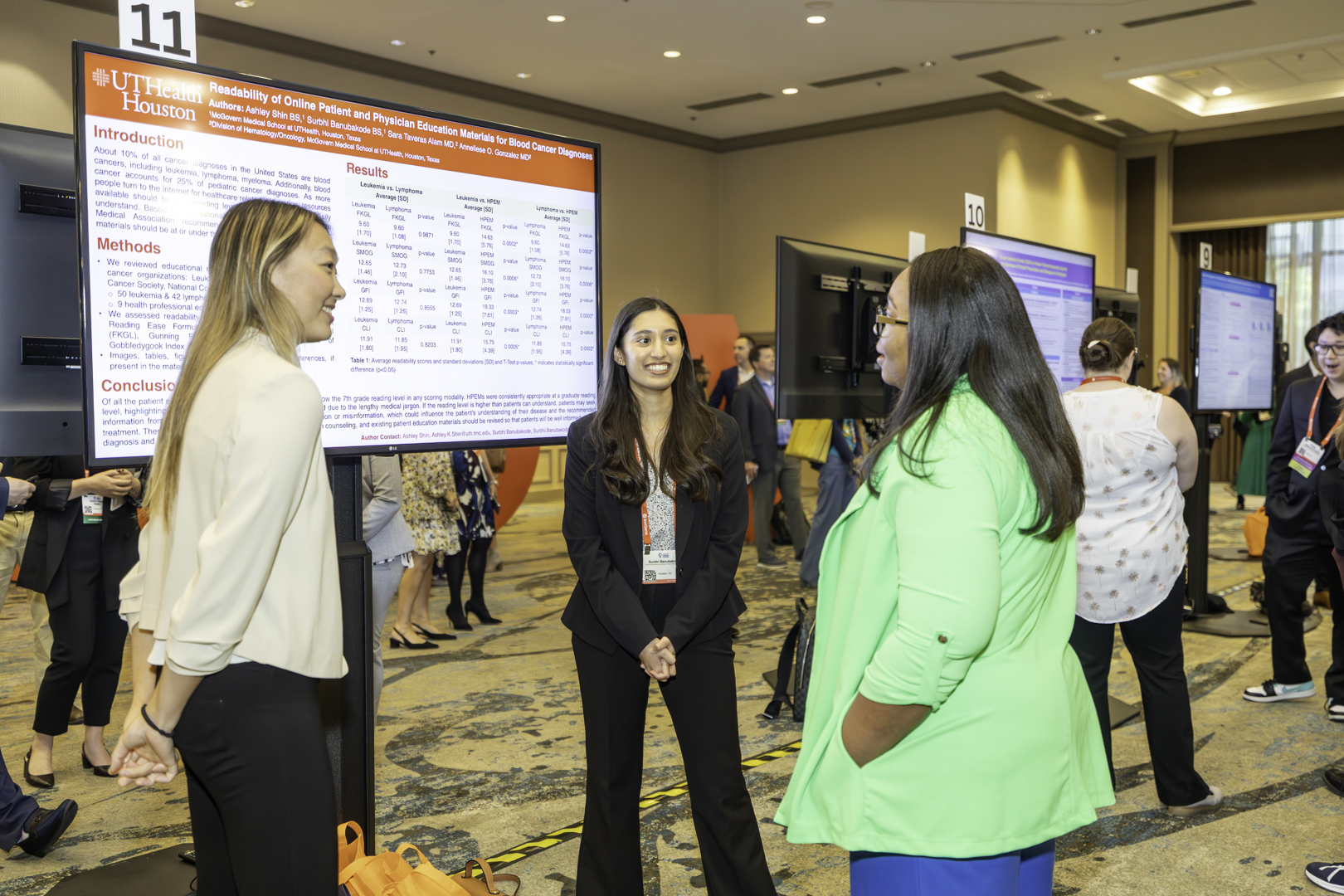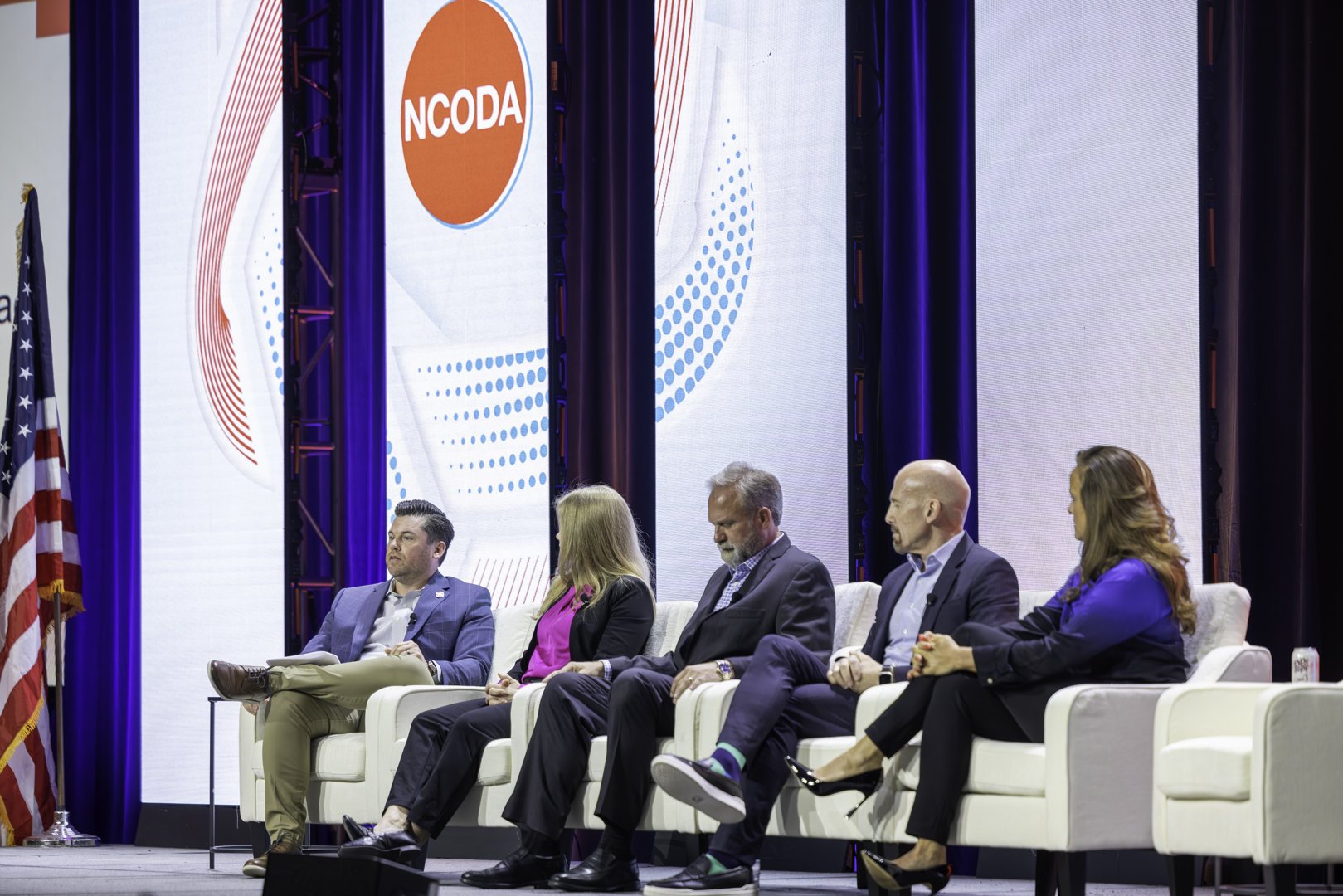2026 International Spring Forum
April 15, 2026 | 12:00 PM EST
Advances in ALK Inhibition in Non-Small Cell Lung Cancer
Published Date: October 14, 2025
Share

Author: Virginia Velez Quinones, MD, Aala Dweik, MD, & Luis E. Raez, MD
Non-small cell lung cancer (NSCLC) comprises approximately 85% of lung cancers1 and is characterized by significant molecular heterogeneity, including anaplastic lymphoma kinase (ALK) rearrangements in about 3% to 7% of all cases globally.2 ALK rearrangements are most prevalent in adenocarcinoma histopathology and in young, never- or light-smoking individuals.3,4
ALK gene rearrangements generate fusion proteins — most commonly EML4- ALK — which activate the ALK tyrosine kinase domain, leading to persistent downstream pathway activation that signal uncontrolled cellular proliferation, survival and tumorigenesis.5
Multiple studies and meta-analyses have demonstrated that ALK gene rearrangements in NSCLC are almost always mutually exclusive with Epidermal Growth Factor Receptor (EGFR) and KRAS mutations.6-9 This underscores ALK-positive NSCLC as an oncogene-addicted subtype, meaning tumor cell growth and survival are highly dependent on the ALK fusion protein. It also emphasizes the importance of molecular testing in NSCLC.6,10
First-line-targeted therapy with ALK tyrosine kinase inhibitors (TKIs) has proven more efficacious than chemotherapy or immunotherapy in patients with advanced ALK-rearranged NSCLC.11 Current guidelines from the National Comprehensive Cancer Network (NCCN) recommend routine ALK testing in all patients diagnosed with advanced NSCLC.12
EVOLUTION OF ALK INHIBITOR THERAPY FROM CRIZOTINIB TO NELADALKIB
The development of ALK TKIs for the treatment of NSCLC began in 2007. This followed the discovery of the EML4-ALK fusion as an oncogenic driver, which spurred rapid progress in targeted therapies.13
Crizotinib was the first ALK TKI developed for NSCLC and is now classified as a first-generation ALK TKI. Originally designed to target MET, crizotinib was later found to also inhibit ALK.14
In 2014, the PROFILE 1014 trial established crizotinib as a superior first-line treatment to platinum-pemetrexed chemotherapy in advanced ALK-positive NSCLC, demonstrating improved progression-free survival (PFS) and objective response rate (ORR). The trial, however found no significant difference in central nervous system (CNS) progression between crizotinib and chemotherapy.15
With crizotinib-resistant disease developing due to secondary mutations, bypass signaling and inadequate brain penetration, the urgency for more advanced, CNS-active ALK inhibitors grew.14 Consequently, second-generation ALK inhibitors — alectinib, ceritinib, brigatinib and ensartinib — emerged.
Ceritinib was the first second-generation ALK inhibitor developed and was especially effective against multiple crizotinib-resistant mutations, including the L1196M gatekeeper mutation. The U.S. Food and Drug Administration approved ceritinib approved in 2014 based on early-phase clinical data.
Ceritinib’s activity was confirmed in the ASCEND-4 Phase 3 trial, which showed that first-line ceritinib significantly extended PFS compared to platinum-pemetrexed chemotherapy in advanced ALK-positive NSCLC, including in patients with brain metastases.
The ASCEND-5 trial later confirmed ceritinib’s benefit in those previously treated with both chemotherapy and crizotinib. Its use, however, is often constrained by frequent gastrointestinal and liver-related side effects.16-19

Alectinib, a highly selective second-generation ALK inhibitor, was approved in 2015 for crizotinib-resistant ALK-positive NSCLC and in 2017 for first-line use in patients with metastatic disease. Unlike ceritinib, alectinib bypasses P-glycoprotein, enabling strong CNS penetration and activity against a broad spectrum of ALK resistance mutations.20-22
The Phase 3 ALEX trial showed that alectinib significantly improved PFS (34.8 vs. 10.9 months) and reduced CNS progression (12% vs. 45%) compared to crizotinib, with better OS and a more favorable safety profile.20,23,24
Brigatinib, like alectinib, was developed to overcome resistance to crizotinib and target CNS metastases in NSCLC. Unlike alectinib, brigatinib also targets ROS1 rearrangements and various ALK resistance mutations — most notably G1202R — and demonstrated unique efficacy against certain EGFR mutations.25
The notable 2014 Phase 2 ALTA trial evaluated brigatinib in patients with advanced ALK-positive NSCLC who had progressed on crizotinib, comparing a 90mg daily dose to a 180mg daily dose. The 180mg regimen demonstrated superior outcomes, with an ORR of 56%, median PFS of 16.7 months, and median OS of 34.1 months. The intracranial ORR was 67% in patients with measurable brain metastases with a PFS reaching 18.4 months, underscoring its potent CNS efficacy alongside a favorable safety profile.26,27
The Phase 3 ALTA trial demonstrated that alectinib and brigatinib offer similar effectiveness in treating advanced ALK-positive NSCLC in patients who have previously progressed on crizotinib.28 This led to the inclusion of brigatinib in clinical guidelines as a preferred option for crizotinib-refractory ALK-positive NSCLC, especially in patients with CNS involvement.24
The eXalt3 trial, conducted between 2016 and 2018, evaluated ensartinib versus crizotinib as first-line treatment in ALK-positive NSCLC, demonstrating significantly extended PFS (25.8 months compared to 12.7 months) and strong activity against both systemic and brain metastases.29 When compared to alectinib and brigatinib, indirect evidence from meta-analyses suggests that these three agents provide comparable PFS outcomes.
Alectinib has remained the preferred option over brigatinib therapy due to its well-established safety profile, broad global acceptance and since it was approved first. Still, ensartinib remains a valid alternative, especially in Asian populations, where some analyses suggest it may perform more favorably.29-33
Lorlatinib, a third-generation ALK TKI, was developed in the early 2010s to target resistance mutations like G1202R and achieve stronger CNS penetration. Following early clinical trials starting in 2014, it gained global approval in 2018 for ALK-positive NSCLC which had progressed on prior ALK TKI treatment.34,35
The pivotal CROWN trial (2017 to 2019), which randomized 296 patients to either lorlatinib or crizotinib, showed lorlatinib significantly improved 12-month PFS rates (78% vs. 39%, HR 0.28) and delivered an 82% intracranial response rate, including 71% complete responses in those with measurable brain metastases.36,37
The updated long-term results from the CROWN trial, as presented at American Society of Clinical Oncology (ASCO) in 2024, continued to show lorlatinib benefit with an unprecedented median PFS not yet reached at 60.2 months compared to 9.3 months with crizotinib and three-year PFS exceeding 60%.36,37 These results surpass those reached with second-generation ALK inhibitors such as alectinib, brigatinib and ensartinib in indirect data comparisons.
Despite its superior efficacy, the adoption of lorlatinib as the first-line standard of care has been affected by its toxicity profile, particularly neurocognitive and metabolic side effects (i.e., hypercholesterolemia and hypertriglyceridemia).36,37 As a result, although NCCN and ASCO guidelines do endorse lorlatinib as a first-line treatment option, alectinib or brigatinib are often recommended first due to favorable safety profiles.
However, this preference remains debated among experts, especially in light of lorlatinib’s superior CNS penetration and durable PFS benefits demonstrated in the CROWN trial.
The Phase 3 ALKAZAR trial, initiated globally in early 2025, is a randomized study comparing neladalkib (NVL-655) — a fourth-generation investigational ALK inhibitor — with alectinib, in treatment-naïve patients with ALK-positive NSCLC. The primary focus of the trial is PFS, while secondary measures include intracranial efficacy, ORR, duration of response, OS, safety, tolerability and patient-reported outcomes.38-40
In the Phase 1/2 ALKOVE-1 trial, neladalkib demonstrated promising early effectiveness in patients with extensively treated ALK-positive NSCLC, including those with resistant ALK mutations and brain metastases. Additionally, the drug showed a tolerable safety profile, aligning with its design that targets ALK while sparing TRK.41
MECHANISMS OF RESISTANCE TO ALK INHIBITORS
Resistance to ALK inhibitors in NSCLC has become a significant therapeutic challenge, limiting the long-term effectiveness of targeted treatments.
This resistance can be primary or secondary and can arise through both ALK-dependent mechanisms — such as secondary mutations in the ALK kinase domain — and ALK-independent pathways, including the activation of alternate signaling routes or transformation of tumor histology. The pattern of resistance mutations varies depending on the type and sequence of ALK TKIs used.42-44
As noted previously, first-generation ALK TKIs like crizotinib initially improved patient outcomes. However, resistance often developed rapidly leading to the adoption of more advanced second-and third-generation agents like alectinib and lorlatinib. Still, resistance eventually emerges even to these newer drugs with complex mutations, sometimes rendering them ineffective.45
Primary resistance to ALK inhibitors is rare and often attributed to genetic alterations or alternative oncogenic drivers that reduce the effectiveness of ALK-targeted therapy. In contrast, secondary resistance is much more prevalent, typically developing after an initial period of response to treatment.
ALK-dependent resistance mechanisms involve mutations within the ALK kinase domain that interfere with drug binding. Frequently observed mutations — such as G1202R, L1196M, I1171T/N, and compound mutations — can lead to resistance against first- and second-generation ALK TKIs, and, in some cases, even to third-generation drugs like lorlatinib.
The presence and frequency of these mutations vary depending on the specific TKI used and the order in which therapies are administered.42,46,47
On the other hand, ALK-independent resistance mechanisms involve the activation of alternative signaling pathways that allow cancer cells to bypass ALK inhibition. These include genetic changes such as mutations or amplifications in EGFR, MET, KRAS or HER2 genes, as well as other alterations like BRAF mutations or transformation of tumor histology. Such mechanisms enable continued tumor growth despite ALK-targeted treatment.
Notably, in cases where no ALK resistance mutation is detected, bypass pathway activation — such as MET amplification or EGFR mutation — is often implicated in treatment failure.42,44,47
Liquid biopsy using circulating tumor DNA (ctDNA) and next-generation sequencing (NGS) is sometimes a valuable tool for identifying resistance mechanisms to ALK inhibitors in NSCLC. However, a key limitation is that most liquid biopsy platforms do not routinely perform RNA-based NGS, which is often necessary for detecting ALK-related mutations and complex rearrangements that contribute to treatment resistance.
This noninvasive method provides a more complete picture of tumor evolution and heterogeneity, especially when tissue biopsy for NGS is not possible or inadequate. Importantly, liquid biopsy results can help guide personalized treatment decisions based on the specific resistance profile observed at progression.42,47-50
As a result, treatment strategies have increasingly focused on precision medicine, emphasizing molecular profiling at disease progression to tailor therapies and fuel development of next-generation ALK inhibitors and combination approaches designed to delay or overcome resistance mechanisms.44,51
COMBINATION STRATEGIES AND EMERGING APPROACHES
Combination strategies are another approach under development to address both ALK-dependent and ALK-independent resistance mechanisms.
These strategies involve targeting the primary ALK driver with ALK TKIs, while also inhibiting alternative signaling pathways using pathway-specific inhibitors. The goal is to suppress tumor cell survival and delay — or potentially overcome — resistance.
Early studies, including preclinical models, suggest that combining ALK inhibitors with agents targeting other pathways — such as EGFR inhibitors in cases of MET amplification — may produce synergistic effects.44,52,53 Other ongoing investigations involve pairing ALK TKIs with chemotherapy, antiangiogenic drugs or immune checkpoint inhibitors, although immunotherapy has shown limited benefit in this patient population.54
MET amplification is a common resistance mechanism to next-generation ALK inhibitors like alectinib, and combining ALK and MET inhibition has emerged as a promising strategy to counter this resistance.
Crizotinib, which targets both ALK and MET, has shown clinical benefit in patients who develop MET amplification following alectinib treatment, with observed tumor responses after switching therapies.55,56 Preclinical models have further demonstrated that combining alectinib with MET inhibitors can reverse MET-driven resistance.
Newer approaches, such as using the MET/EGFR bispecific antibody amivantamab with alectinib, have shown enhanced antitumor activity via both signaling blockade and immune mechanisms.57 However, due to the frequent presence of additional genetic alterations, such as mutations in TP53, EGFR, or MYC in MET-amplified tumors, responses to combination therapy may vary.58 Therefore, thorough molecular profiling at disease progression is critical to tailor treatment and determine the most effective therapeutic strategy.
CONCLUSION
The treatment landscape for ALK-positive NSCLC has evolved significantly over the past decade, with successive generations of ALK TKIs offering improved efficacy, CNS penetration and coverage of resistance mutations.
Among these, lorlatinib has demonstrated superior PFS and unmatched CNS activity, particularly in the CROWN trial, positioning it as a potential optimal first-line agent. However, despite its clinical advantages, lorlatinib’s broader adoption has been tempered by its toxicity profile, most notably neurocognitive effects and metabolic abnormalities.
Although NCCN and ASCO guidelines endorse lorlatinib as first-line option, alectinib or brigatinib are often recommended first in practice due to more favorable safety profiles. Still, this preference remains a topic of ongoing debate among experts, particularly in patients with high risk for CNS involvement and those more likely to develop resistant mutations, where the durable disease control of lorlatinib may outweigh its toxicity risks.
Acquired resistance to both ALK-dependent and ALK-independent pathways continues to challenge the durability of response, highlighting the need for ongoing molecular monitoring and precision medicine approaches. Repeat molecular testing using tissue or liquid biopsy with NGS enables real-time detection of resistance alterations allowing for the implementation of personalized treatment strategies.
Looking forward, the emergence of fourth-generation inhibitors such as neladalkib (NVL-655) and rational combination therapies targeting bypass pathways, including MET amplification, reflect promising avenues to extend disease control. Continued research into resistance biology and individualized therapy selection remains essential to improving long-term outcomes in patients with ALK-rearranged NSCLC.
Additional Information
1. Molina JR, Yang P, Cassivi SD, Schild SE, Adjei AA. Non-small cell lung cancer: epidemiology, risk factors, treatment, and survivorship. Mayo Clin Proc. 2008;83(5):584-594. doi:10.4065/83.5.584.
2. Sullivan I, Planchard D. ALK inhibitors in non-small cell lung cancer: the latest evidence and developments. Ther Adv Med Oncol. 2016;8(1):32-47. doi:10.1177/1758834015617355.
3. Fan L, Feng Y, Wan H, Shi G, Niu W. Clinicopathological and demographical characteristics of non-small cell lung cancer patients with ALK rearrangements: a systematic review and meta-analysis. PLoS One. 2014;9(6):e100866. Published 2014 Jun 24. doi:10.1371/journal. pone.0100866.
4. Allen TC, Xiao Y, Yang B, et al. Anaplastic lymphoma kinase rearrangement prevalence in patients with advanced non-small cell lung cancer in the United States: retrospective real world data. Oncotarget. 2021;12(23):2308-2315. Published 2021 Nov 9. doi:10.18632/oncotarget.28114.
5. Shreenivas A, Janku F, Gouda MA, et al. ALK fusions in the pan-cancer setting: another tumor-agnostic target? NPJ Precis Oncol. 2023;7(1):101. Published 2023 Sep 29. doi:10.1038/s41698-023-00449-x.
6. Schneider JL, Lin JJ, Shaw AT. ALK-positive lung cancer: a moving target. Nat Cancer. 2023;4(3):330-343. doi:10.1038/s43018-023- 00515-0.
7. Gainor JF, Varghese AM, Ou SH, et al. ALK rearrangements are mutually exclusive with mutations in EGFR or KRAS: an analysis of 1,683 patients with non-small cell lung cancer. Clin Cancer Res. 2013;19(15):4273-4281. doi:10.1158/1078-0432.CCR-13-0318.
8. Zhao F, Xu M, Lei H, et al. Clinicopathological characteristics of patients with non-small-cell lung cancer who harbor EML4-ALK fusion gene: a meta-analysis. PLoS One. 2015;10(2):e0117333. Published 2015 Feb 23. doi:10.1371/journal. pone.0117333.
9. Wang J, Dong Y, Cai Y, et al. Clinicopathologic characteristics of ALK rearrangements in primary lung adenocarcinoma with identified EGFR and KRAS status. J Cancer Res Clin Oncol. 2014;140(3):453-460. doi:10.1007/s00432-014- 1584-8.
10. Nana-Sinkam SP, Powell CA. Molecular biology of lung cancer: Diagnosis and management of lung cancer, 3rd ed: American College of Chest Physicians evidence-based clinical practice guidelines. Chest. 2013;143(5 Suppl):e30S-e39S. doi:10.1378/chest.12-2346.
11. Singh N, Temin S, Baker S Jr, et al. Therapy for Stage IV Non-Small-Cell Lung Cancer With Driver Alterations: ASCO Living Guideline. J Clin Oncol. 2022;40(28):3310-3322. doi:10.1200/ JCO.22.00824.
12. Riely GJ, Wood DE, Ettinger DS, et al. Non- Small Cell Lung Cancer, Version 4.2024, NCCN Clinical Practice Guidelines in Oncology. J Natl Compr Canc Netw. 2024;22(4):249-274. doi:10.6004/jnccn.2204.0023.
13. Soda M, Choi YL, Enomoto M, et al. Identification of the transforming EML4–ALK fusion gene in non–small-cell lung cancer. Nature. 2007;448:561–566. doi:10.1038/nature05945
14. Blackhall F, Cappuzzo F. Crizotinib: from discovery to accelerated development to front-line treatment [published correction appears in Ann Oncol. 2018 Apr 1;29(4):1073. doi: 10.1093/annonc/mdx121.]. Ann Oncol. 2016;27 Suppl 3:iii35-iii41. doi:10.1093/annonc/mdw304.
15. Solomon BJ, Mok T, Kim DW, et al. First-line crizotinib versus chemotherapy in ALK-positive lung cancer [published correction appears in N Engl J Med. 2015 Oct 15;373(16):1582. doi: 10.1056/NEJMx150034.]. N Engl J Med. 2014;371(23):2167-2177. doi:10.1056/NEJMoa1408440.
16. Reck M, Rabe KF. Precision Diagnosis and Treatment for Advanced Non-Small-Cell Lung Cancer. N Engl J Med. 2017;377(9):849-861. doi:10.1056/NEJMra1703413.
17. Shaw AT, Kim TM, Crinò L, et al. Ceritinib versus chemotherapy in patients with ALK-rearranged non-small-cell lung cancer previously given chemotherapy and crizotinib (ASCEND-5): a randomised, controlled, open-label, Phase 3 trial. Lancet Oncol. 2017;18(7):874-886. doi:10.1016/S1470- 2045(17)30339-X.
18. Soria JC, Tan DSW, Chiari R, et al. First-line ceritinib versus platinum-based chemotherapy in advanced ALK-rearranged non-small-cell lung cancer (ASCEND-4): a randomised, open-label, Phase 3 study [published correction appears in Lancet. 2017 Mar 4;389(10072):908. doi: 10.1016/S0140-6736(17)30603-7.]. Lancet. 2017;389(10072):917-929. doi:10.1016/S0140- 6736(17)30123-X.
19. Mok TSK, Crino L, Felip E, et al. The accelerated path of ceritinib: Translating pre-clinical development into clinical efficacy. Cancer Treat Rev. 2017;55:181-189. doi:10.1016/j. ctrv.2017.03.006..
20. Peters S, Camidge DR, Shaw AT, et al. Alectinib versus Crizotinib in Untreated ALK-Positive Non-Small-Cell Lung Cancer. N Engl J Med. 2017;377(9):829-838. doi:10.1056/ NEJMoa1704795.
21. Paik J, Dhillon S. Alectinib: A Review in Advanced, ALK-Positive NSCLC. Drugs. 2018;78(12):1247-1257. doi:10.1007/s40265- 018-0952-0.
22. Gadgeel S, Peters S, Mok T, et al. Alectinib versus crizotinib in treatment-naive anaplastic lymphoma kinase-positive (ALK+) non-small-cell lung cancer: CNS efficacy results from the ALEX study. Ann Oncol. 2018;29(11):2214-2222. doi:10.1093/annonc/mdy405.
23. Mok T, Camidge DR, Gadgeel SM, et al. Updated overall survival and final progression-free survival data for patients with treatment-naive advanced ALK-positive non-small-cell lung cancer in the ALEX study. Ann Oncol. 2020;31(8):1056- 1064. doi:10.1016/j.annonc.2020.04.478.
24. Riely GJ, Wood DE, Ettinger DS, et al. Non- Small Cell Lung Cancer, Version 4.2024, NCCN Clinical Practice Guidelines in Oncology. J Natl Compr Canc Netw. 2024;22(4):249-274. doi:10.6004/jnccn.2204.0023.
25. Zhang S, Anjum R, Squillace R, et al. The Potent ALK Inhibitor Brigatinib (AP26113) Overcomes Mechanisms of Resistance to First- and Second-Generation ALK Inhibitors in Preclinical Models. Clin Cancer Res. 2016;22(22):5527-5538. doi:10.1158/1078-0432.CCR-16-0569.
26. Huber RM, Hansen KH, Paz-Ares Rodríguez L, et al. Brigatinib in Crizotinib-Refractory ALK+ NSCLC: 2-Year Follow-up on Systemic and Intracranial Outcomes in the Phase 2 ALTA Trial. J Thorac Oncol. 2020;15(3):404-415. doi:10.1016/j. jtho.2019.11.004.
27. Camidge DR, Kim DW, Tiseo M, et al. Exploratory Analysis of Brigatinib Activity in Patients With Anaplastic Lymphoma Kinase-Positive Non- Small-Cell Lung Cancer and Brain Metastases in Two Clinical Trials. J Clin Oncol. 2018;36(26):2693- 2701. doi:10.1200/JCO.2017.77.5841.
28. Yang JC, Liu G, Lu S, et al. Brigatinib Versus Alectinib in ALK-Positive NSCLC After Disease Progression on Crizotinib: Results of Phase 3 ALTA-3 Trial. J Thorac Oncol. 2023;18(12):1743- 1755. doi:10.1016/j.jtho.2023.08.010.
29. Horn L, Wang Z, Wu G, et al. Ensartinib vs Crizotinib for Patients With Anaplastic Lymphoma Kinase-Positive Non-Small Cell Lung Cancer: A Randomized Clinical Trial. JAMA Oncol. 2021;7(11):1617- 1625. doi:10.1001/jamaoncol.2021.3523.
30. Ma HC, Liu YH, Ding KL, et al. Comparative efficacy and safety of first-line treatments for advanced non-small cell lung cancer with ALK-rearranged: a meta-analysis of clinical trials. BMC Cancer. 2021;21(1):1278. Published 2021 Nov 26. doi:10.1186/s12885-021-08977-0.
31. Wu KL, Chen HL, Tsai YM, et al. First-Line Anaplastic Lymphoma Kinase (ALK) Inhibitors for ALK-Positive Lung Cancer in Asian Populations: Systematic Review and Network Meta-Analysis. J Clin Med. 2021;10(19):4376. Published 2021 Sep 25. doi:10.3390/jcm10194376.
32. Zhao M, Shao T, Shao H, Zhou C, Tang W. Identifying optimal ALK inhibitors in first- and second-line treatment of patients with advanced ALK-positive non-small-cell lung cancer: a systematic review and network meta-analysis. BMC Cancer. 2024;24(1):186. Published 2024 Feb 8. doi:10.1186/s12885-024-11916-4.
33. Wang WQ, Xu T, Zhang JJ, et al. A comprehensive clinical evaluation of first-line drugs for ALK-positive advanced non-small cell lung cancer. J Thorac Dis. 2023;15(4):1935-1947. doi:10.21037/jtd-23-380.
34. Syed YY. Lorlatinib: First Global Approval. Drugs. 2019;79(1):93-98. doi:10.1007/s40265- 018-1041-0.
35. Shaw AT, Felip E, Bauer TM, et al. Lorlatinib in non-small-cell lung cancer with ALK or ROS1 rearrangement: an international, multicentre, open-label, single-arm first-in-man Phase 1 trial. Lancet Oncol. 2017;18(12):1590-1599. doi:10.1016/S1470-2045(17)30680-0.
36. Solomon BJ, Bauer TM, Mok TSK, et al. Efficacy and safety of first-line lorlatinib versus crizotinib in patients with advanced, ALK-positive non-small-cell lung cancer: updated analysis of data from the Phase 3, randomised, open-label CROWN study. Lancet Respir Med. 2023;11(4):354-366. doi:10.1016/S2213- 2600(22)00437-4.
37. Shaw AT, Bauer TM, de Marinis F, et al. First-Line Lorlatinib or Crizotinib in Advanced ALK-Positive Lung Cancer. N Engl J Med. 2020;383(21):2018- 2029. doi:10.1056/NEJMoa2027187.
38. Damuzzo V, Gasperoni L, Del Bono L, Ossato A, Inno A, Messori A. Treatment of metastatic ALK-positive non-small cell lung cancer: indirect comparison of different ALK inhibitors using reconstructed patient data. Front Oncol. 2025;15:1566816. Published 2025 May 9. doi:10.3389/fonc.2025.1566816.
39. Lorlatinib [package insert]. DailyMed. U.S. National Library of Medicine. Published 2023. Accessed June 11, 2025. https://dailymed.nlm.nih.gov/ dailymed/drugInfo.cfm?setid=2b34d62d-e02a- 4af3-bc0d-1571dd4ee76dhttps://dailymed.nlm. nih.gov/dailymed/drugInfo.cfm?setid=2b34d62d-e02a-4af3-bc0d-1571dd4ee76d.
40. Popat S, Solomon BJ, Stinchcombe T, et al. Neladalkib (NVL-655), a highly selective anaplastic lymphoma kinase (ALK) inhibitor, compared to alectinib in first-line treatment of patients with ALK-positive advanced non-small cell lung cancer: The Phase 3 ALKAZAR study. J Clin Oncol. 2025;43(16_suppl):TPS8666. doi:10.1200/ JCO.2025.43.16_suppl.TPS8666.
41. Drilon AE, et al. Phase 1/2 ALKOVE-1 study of NVL-655 in ALK-positive (ALK+) solid tumors. ESMO Congress 2024, Abstract 1253O Proffered Paper Session – NSCLC metastaticProffered Paper Session – NSCLC metastatic, 14.09.2024, h. 08:30 – 10:00, Barcelona Auditorium – Hall 2.
42. Lin YT, Chiang CL, Hung JY, et al. Resistance profiles of anaplastic lymphoma kinase tyrosine kinase inhibitors in advanced non-small-cell lung cancer: a multicenter study using targeted next-generation sequencing. Eur J Cancer. 2021;156:1-11. doi:10.1016/j.ejca.2021.06.043.
43. Yanagitani N, Uchibori K, Koike S, et al. Drug resistance mechanisms in Japanese anaplastic lymphoma kinase-positive non-small cell lung cancer and the clinical responses based on the resistant mechanisms. Cancer Sci. 2020;111(3):932-939. doi:10.1111/ cas.14314.
44. Cooper AJ, Sequist LV, Lin JJ. Third-generation EGFR and ALK inhibitors: mechanisms of resistance and management [published correction appears in Nat Rev Clin Oncol. 2022 Nov;19(11):744. doi: 10.1038/s41571-022-00680- 8.]. Nat Rev Clin Oncol. 2022;19(8):499-514. doi:10.1038/s41571-022-00639-9.
45. Itchins M, Lau B, Hudson AL, et al. ALK-Rearranged Non-Small Cell Lung Cancer in 2020: Real-World Triumphs in an Era of Multigeneration ALK-Inhibitor Sequencing Informed by Drug Resistance Profiling. Oncologist. 2020;25(8):641-649. doi:10.1634/theoncologist.2020-0075.
46. Yanagitani N, Uchibori K, Koike S, et al. Drug resistance mechanisms in Japanese anaplastic lymphoma kinase-positive non-small cell lung cancer and the clinical responses based on the resistant mechanisms. Cancer Sci. 2020;111(3):932-939. doi:10.1111/ cas.14314.
47. Sánchez-Herrero E, Serna-Blasco R, Ivanchuk V, et al. NGS-based liquid biopsy profiling identifies mechanisms of resistance to ALK inhibitors: a step toward personalized NSCLC treatment. Mol Oncol. 2021;15(9):2363-2376. doi:10.1002/1878-0261.13033.
48. McCoach CE, Blakely CM, Banks KC, et al. Clinical Utility of Cell-Free DNA for the Detection of ALK Fusions and Genomic Mechanisms of ALK Inhibitor Resistance in Non-Small Cell Lung Cancer. Clin Cancer Res. 2018;24(12):2758-2770. doi:10.1158/1078-0432.CCR-17-2588.
49. Hua G, Zhang X, Zhang M, et al. Real-world circulating tumor DNA analysis depicts resistance mechanism and clonal evolution in ALK inhibitor-treated lung adenocarcinoma patients. ESMO Open. 2022;7(1):100337. doi:10.1016/j. esmoop.2021.100337.
50. Cognigni V, Pecci F, Lupi A, et al. The Landscape of ALK-Rearranged Non-Small Cell Lung Cancer: A Comprehensive Review of Clinicopathologic, Genomic Characteristics, and Therapeutic Perspectives. Cancers (Basel). 2022;14(19):4765. Published 2022 Sep 29. doi:10.3390/cancers14194765.
51. Steuer CE, Ramalingam SS. ALK-positive non-small cell lung cancer: mechanisms of resistance and emerging treatment options. Cancer. 2014;120(16):2392-2402. doi:10.1002/ cncr.28597.
52. Michaux L, Perrier A, Mehlman C, et al. Therapeutic strategies to overcome EGFR mutations as acquired resistance mechanism in ALK-rearranged non-small-cell lung cancer: Case Reports. Front Oncol. 2023;13:1182558. Published 2023 Jun 28. doi:10.3389/ fonc.2023.1182558.
53. Papageorgiou S, Pashley SL, O’Regan L, Khan S, Bayliss R, Fry AM. Alternative Treatment Options to ALK Inhibitor Monotherapy for EML4-ALK-Driven Lung Cancer. Cancers (Basel). 2022;14(14):3452. Published 2022 Jul 15. doi:10.3390/cancers14143452.
54. Fukui T, Tachihara M, Nagano T, Kobayashi K. Review of Therapeutic Strategies for Anaplastic Lymphoma Kinase-Rearranged Non-Small Cell Lung Cancer. Cancers (Basel). 2022;14(5):1184. Published 2022 Feb 24. doi:10.3390/cancers14051184.
55. Dagogo-Jack I, Yoda S, Lennerz JK, et al. MET Alterations Are a Recurring and Actionable Resistance Mechanism in ALK-Positive Lung Cancer. Clin Cancer Res. 2020;26(11):2535-2545. doi:10.1158/1078-0432.CCR-19-3906.
56. Shi R, Filho SNM, Li M, et al. BRAF V600E mutation and MET amplification as resistance pathways of the second-generation anaplastic lymphoma kinase (ALK) inhibitor alectinib in lung cancer. Lung Cancer. 2020;146:78-85. doi:10.1016/j.lungcan.2020.05.018.
57. Nishi T, Morita A, Hara N, et al. Efficacy of amivantamab, a bi-specific antibody targeting EGFR and MET, in ALK-rearranged non-small-cell lung cancer cell lines. Lung Cancer. 2025;201:108415. doi:10.1016/j.lungcan.2025.108415.
58. Dagogo-Jack I, Kiedrowski LA, Lennerz JK. Molecular heterogeneity and co-altered genes in MET-amplified ALK-positive lung cancer: Implications for MET targeted therapy. Lung Cancer. 2023;186:107383. doi:10.1016/j.lungcan.2023.107383.






